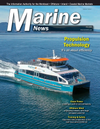
Page 55: of Marine News Magazine (July 2020)
Propulsion Technology
Read this page in Pdf, Flash or Html5 edition of July 2020 Marine News Magazine
Great Lakes Shipyard Launches Tug Wisconsin propulsion system includes the Logan
FlexaDrive Hybrid power system, allow- ing the tug to operate on electric power while at idle, underway at low speeds or when under low loads, without the need to utilize the main engines, reducing emis- sions and the cost of engine maintenance.
The tugs Cleveland, Ohio, Michigan and Pennsylvania were the ?rst new tugs built in the series as part of the Towing
Company’s ?eet renewal program.
7KH*UHDW/DNHV*URXS
The Great Lakes Shipyard launched Lakes Towing Company. The ?rm has recently committed to the new tug Wisconsin, the ?fth in a se- Wisconsin, like its sister tugs, is pow- building a sixth tug (yet to be named), ries of 64-foot Damen Stan tug 1907 Ice ered by two 1,000-horsepower MTU which is currently under construc- design harbor tugs that the Cleveland, 8V4000 Tier III diesel engines, and gen- tion and scheduled to be completed in
Ohio shipyard is building for The Great erates over 30-tons of bollard pull. Its Spring 2021.
$%%+\EULGHOHFWULF3URSXOVLRQIRU:6)1HZEXLOGV
U.S. shipbuilding company Vigor has selected ABB to supply the hybrid-electric propulsion and energy storage systems for the newest additions to the Washington
State Ferry ?eet, setting the largest U.S. ferry system on course to drastically reduce greenhouse gas emissions and fuel use.
9LJRU
The new Olympic Class ferries, each with a capacity of 144 cars and 1,500 in Seattle. “This landmark project sup- ing Director, ABB Marine & Ports.
passengers, with the planned addition of ports Washington State’s goal for 2050 Washington State Ferries is the largest charging capability at terminals, would to reduce emissions by 57.5% below the ferry system in the U.S. By 2040, the reduce fuel consumption by up to 95%. emissions level in 2019,” Herbert said. Washington Ferry System plan is to re-
Upon delivery in 2024, the initial vessel Leveraging ABB’s onboard DC Grid place 13 existing diesel ferries with hy- of the series will be the ?rst newbuild in power distribution system and drive brid-electric newbuilds and to convert the WSF ?eet to feature hybrid-electric technology, the new ferry design will six other ferries to plug-in hybrid, with propulsion and a high capacity ESS. optimize energy use, whether drawing recharging capacity installed at many
The vessels will be able to fully operate on main engine power, battery power or ferry terminals. All hybrid vessels will on battery power, with the capability to a combination of the two. The battery be capable of charging at the terminal, revert to hybrid mode if needed. power can also extend zero-emissions ca- and some of the vessels will be capable
Jay Hebert, VP, Marine Fabrication, pability along the supply chain by using of operating in fully electric mode on
Vigor, said the project is prompted by the renewables and hydroelectric power. shorter routes. With the addition of commitment of Washington Governor “Moving toward a dramatically re- newer-built, clean energy ferries to the
Jay Inslee, the state legislature and WSF duced-emission future relies on technol- ?eet, fuel consumption is projected at to replace aging ferries with clean technol- ogies that meet the environmental and 9.5 million gallons in 2040, compared ogy. The 2019 legislature approved initial cost needs of today – and offer ?exibility to 19 million gallons in 2018, with funding for the ?rst of the new vessels, to to integrate future energy sources in the CO2 emissions expected to fall below be built at Vigor’s Harbor Island shipyard years ahead,” said Juha Koskela, Manag- 2050 reduction targets by 2034.
55 www.marinelink.com MN

 54
54

 56
56
